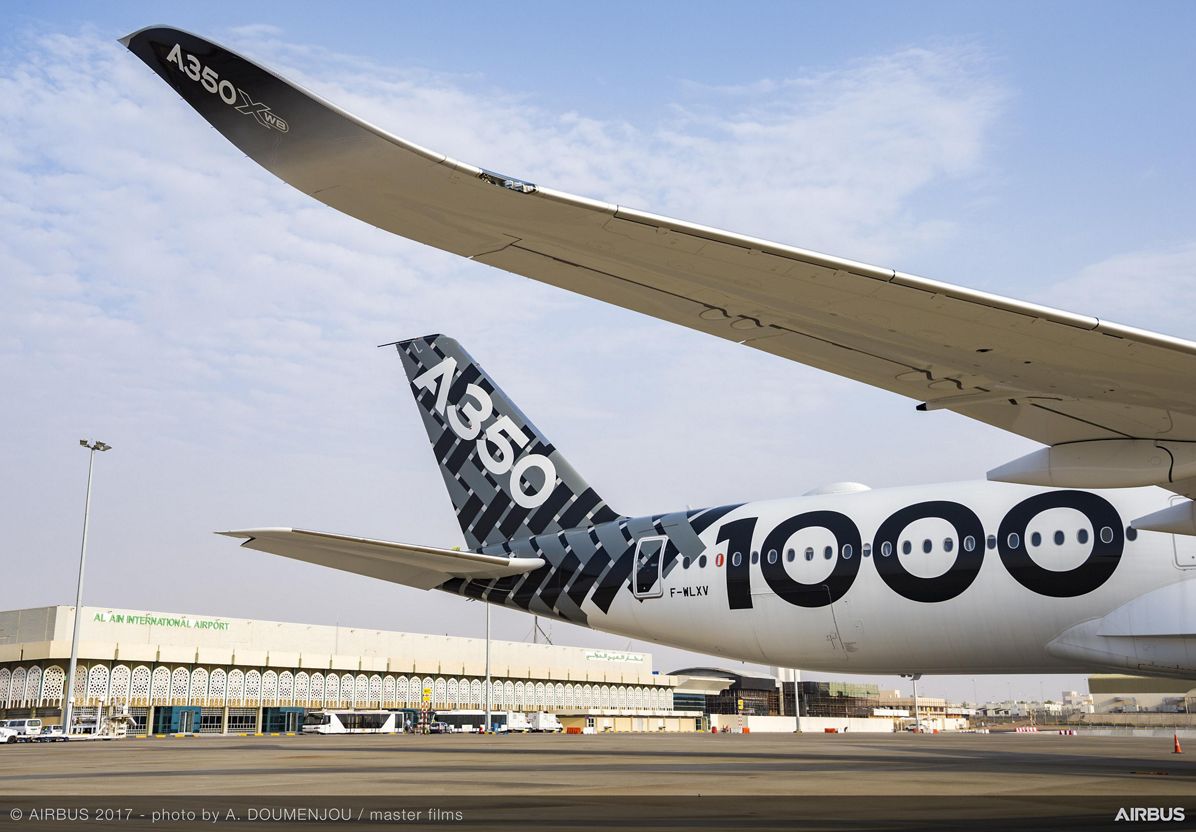Leeham News and Analysis
There's more to real news than a news release.
Singapore airlines increases order for 787-10
By Bjorn Fehrm
Subscription Required
Introduction
Oct. 26, 2017, © Leeham Co.: Singapore airlines increased its order for Boeing’s 787-10 from 20 to 39 this week. The first aircraft for the airline rolled off the assembly earlier this month. It will now be prepared for delivery, flying out to Singapore on the new year.
The 787-10 is essentially a 787-9 which can take more passengers. By it, the cost per passenger goes down.
How much better? By comparing with the closest competitor, Airbus A350-900, we can learn by how much.
We will use our performance model to compare the aircraft. It’s a bit apples and oranges, because the A350-900 is a long-range airliner with 8,000nm range, and the 787-10 sacrifices the range of the -9 variant to carry more passengers.
But it’s interesting to see how this sacrifice pays off in efficiency on the type of routes the 787-10 was designed for.
Summary:
- The 787-10 is optimized to carry 330 passengers out to 6,400nm. It does this with a well-packaged fuselage and the wing of the smaller 787-9.
- The A350-900 is larger. It has a larger wing, to fly longer. And its fuselage diameter brings more passenger comfort, especially in economy.
- With both built with weight-saving carbon fiber technology, it’s not surprising the 787-10 is lighter, despite holding a row more of passengers.
- Weight and size always cost fuel. The difference in fuel burn is consistent with the difference in aircraft capabilities.
Trump decertifies Iran nuke deal, throws Airbus, Boeing orders in doubt
Subscription Required
Introduction
Oct. 16, 2017, © Leeham Co.: President Donald Trump announced Friday he will decertify the Iran nuclear deal, throwing into doubt a host of related commercial deals, including huge aircraft orders.

Iran Air Airbus A330. Photo via Google.
Trump hasn’t gone so far as to withdraw from the pact, but he still threatens to do so unless Congress makes changes he wants.
Here in the US, focus is, of course, on the commitment by Iran for Boeing aircraft—none of which are firm contracts, but “commitments” to order.
Of less focus here, if any, is on the outstanding orders placed by Iran for Airbus and ATR aircraft, which are subject to US licensing.
Summary
- 30 Boeing 777s, including 15 Classics are at stake.
- 50 Boeing 737 MAXes to Iran Air and 30 to Iran Asesman are also at stake.
- ATR has 11 aircraft scheduled for delivery in 2018.
- Airbus sold 114 A320s/321s, A330s and A350s to Iran Air. A few white tails already have been delivered.
Boeing’s Bold Ambition, Part 2
Subscription Required
Introduction
Oct. 9, 2017, © Leeham Co.: When Boeing launched the 787 program in 2003, an after-market maintenance program called Gold Care followed.
It wasn’t successful. Few customers signed up for it.

Stan Deal, CEO of Boeing Global Services.
But the lessons learned are important for Boeing’s drive to vastly expand its presence in the global commercial airplane after-market business.
Boeing Commercial Airplanes and Boeing Defense, Space & Security (and the latter’s predecessor, Integrated Defense Systems) provided services to the airlines, lessors and government customers, but now there is a dedicated business unit.
Boeing Global Services was announced nearly one year ago, on Nov. 21. When Boeing reports its third quarter earnings at the end of this month, for the first time revenues and profits for BGS and its predecessors will be a line-item in the earnings statements.
Stan Deal, the CEO of BGS, acknowledged the poor start of Gold Care in an interview with LNC. But from this unhappy experience, Boeing learned what officials hope lays the foundation of a new, robust business.
Summary
- 787 Gold Care didn’t start out well.
- Gold Care is rejigged and rebranded.
- BGS services Airbus aircraft, too.
Airbus preparing to hike A350 production rate
Subscription Required
Introduction
Oct. 5, 2017, © Leeham Co.: Airbus is gearing up to increase the production rate of the A350 from 2018’s planned 10/mo to 13/mo, perhaps as early as the following year, LNC has learned.
year, LNC has learned.
The move follows Boeing’s announcement in September that it will increase the production of the 787 from the current 12/mo to 14/mo in 2019.
Airbus is producing the A330 at a rate of 6/mo.
American hopeful Trump Administration will take on Mid-East 3 airlines
Subscription Required
Introduction
Oct. 2, 2017, © Leeham Co., Grapevine (TX): American Airlines officials dodged commenting about the specifics of the Boeing-Bombardier trade dispute when asked about it at the investors/media day last week in this Dallas suburb.
Instead, the general counsel, Steve Johnson, offered up only a general statement supporting the Trump Administration’s hard line on trade.
The reason for this generality is obvious: American, along with Delta Air Lines and United Airlines, is engaged in its own trade war and needs support from the Administration.
AA, DL and UA are battling Big Three airlines from the Middle East over being subsidized and abusing Open Skies treaties. The US carriers want Trump to knock down the ME3, Emirates Airlines, Qatar Airways and Etihad Airways.
Oddly, no question was asked of the American officials about the current state of the battle during the day.
LNC asked American CEO Doug Parker about the issue following the event, however.
Summary
- Recent meeting with US was encouraging.
- No commitment yet from Trump Administration.
- Market conditions don’t matter to ME3, American says
Airbus is working on a 7,000nm A330-900
By Bjorn Fehrm
Subscription Required
Introduction
September 28, 2017, © Leeham Co.: Airbus is working on increasing the range of the larger variant of the A330neo to 7,000nm. The present version, A330-900, flies 287 passengers 6,550nm, according to Airbus.
The range increase, which comes about from a take-off weight increase, is designed to make the A330-900 more of a competitor to the best-selling Boeing 787-9.
But the Airbus 7,000nm is not comparable to the 787-9’s 7,635nm with 290 passengers. The companies disagree on most principles on how to measure an airliner’s maximum range.
 We use our aircraft model to weed out the differences and tell what is the comparable capabilities of the new A330-900neo variant compared with its main competitor, 787-9.
We use our aircraft model to weed out the differences and tell what is the comparable capabilities of the new A330-900neo variant compared with its main competitor, 787-9.
Summary
- The A330-900 is capable of transporting 287 passengers 7,000nm when using Airbus rules.
- When using rules closer to the ones used by airlines, the range is shorter.
- We apply airline rules to A330-900 and 787-9 and compare their capabilities using our performance model.
Read more
VLA sector dead, Boeing claims, but Large Wide Body also struggles
Subscription Required
Introduction
Sept. 26, 2017, © Leeham Co.: Boeing declared the Very Large Aircraft sector dead in its most recent Current Market Outlook, removing the category entirely when the 2017 CMO was revealed at the Paris Air Show.

Airbus A350-1000. Sales are slow–is the 350-450 seat sector the next VLA? Airbus photo.
But the Large Wide Body (LWB) category appears to be on life support.
The LWB is 350-seats and above. This includes the Boeing 777-300ER, which is already on its way out, the 777-8, the 777-9 and the Airbus A350-1000.
The Medium Wide Body (MWB) category centers around 300 seats. This includes the A330-900, A350-900, 777-200LR and 787-10.
The Small Wide Body (SWB) includes the 787-8, 787-9, A330-200 and A330-800 in the 220-275 seat sector, twin-aisle aircraft. This does not include the 220-240 seat high density Airbus A321neo and Boeing 737-10 single-aisle aircraft.
Boeing’s CMO defines the twin-aisle markets differently: Small wide-body: <300 seats, Large wide-body: >300 seats.
Summary
- Airlines prefer smaller wide bodies.
- Downsizing trend begun with 787 continues.
- Smaller outsells larger in seven of last 10 years.
- Two of the three years involved extraordinary events.
Boeing’s bold ambition
Subscription Required
Introduction
Sept. 25, 2017, © Leeham Co.: The ambitious plan of Boeing CEO Dennis Muilenburg to grow after-market services from today’s $14bn in revenues to $50bn in 5-10

Stan Deal, CEO of Boeing Global Services.
years was announced nearly a year ago—Nov. 21.
Boeing Global Services, or BGS, combines separate operations in Boeing Commercial Airplanes and Boeing Defense, Space and Security (BCA and BDS respectively).
The growth depends on a combination of improving its current operations, growing organically and through mergers and acquisitions.
Wall Street aerospace analysts generally regard the timeline as ambitious.
In an interview with LNC, the CEO of BGS, Stan Deal, agreed.
Summary
- Muilenburg’s bold ambition.
- The next 100 years.
- Creating a value proposition.




